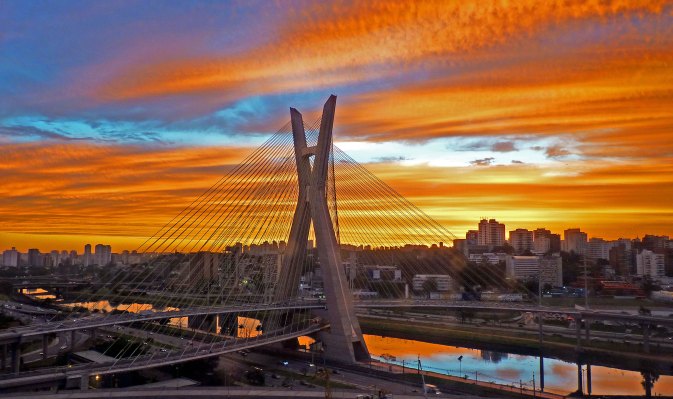It would be foolish to dismiss Latin America as a has-been after the past couple years of economic turmoil. Granted, the region is no longer minting unicorns at the pace it used to, but fewer SoftBank-backed high spenders in the region is not necessarily a bad thing, especially when there are so many cash-efficient startups willing to challenge incumbents.
More often than not, Latin America’s most interesting disruptors tackle problems related to fintech. It makes sense for them to: In a region where financial inclusion has a long way to go, fintech is more innovative and impactful than one may think. However, people in the region need a lot more than fintech, and startups are taking on these problems head-on.
“We anticipate that other colossal sectors like healthcare, logistics, communications and agriculture will experience substantial disruption in the near future,” said Julio Vasconcellos, a managing partner at VC firm Atlantico.
And according to Denis Pedreira of Prosus, education is also a space where technology will play a key role in closing the skills gap in the region. “There is a clear need for access to affordable and quality training, and traditional school models are being challenged. Technologies like AI will change the way we learn in K-12, higher education and the workplace,” he told TechCrunch+.
We’re widening our lens, looking for more founders and investors to participate in TechCrunch+ surveys, where we poll top professionals about challenges and opportunities in their industry.
If you’re a founder or investor and would like to participate in future surveys, fill out this form.
Solving problems for Latin Americans doesn’t necessarily mean going B2C (business-to-consumer), though. There are a lot of pure B2B (business-to-business) plays that can address issues behind the scenes, from open banking APIs and supply chain management to vertical SaaS.
“In our case,” said Marta Cruz, a managing partner at NXTP Ventures, “we could not be more confident in our investment thesis, which aims only to invest in B2B startups, with the conviction that software companies are building long-term competitive advantages in underpenetrated markets.”
Because underpenetrated markets are always a business opportunity and talent can come from everywhere, Latin America is rife with startups these days. “As regional investors, we see lots of movement from countries like Colombia, Mexico, Chile and Argentina,” said Geraldo Melzer, founding partner of ABSeed Ventures.
Anecdotally, this is also confirmed by Magma Partners’ portfolio. “Some of our best investments, including Kushki, Global66, Houm, FZ Sports and Prometeo, come from smaller Latin American markets,” the firm’s managing partner Nathan Lustig told TechCrunch+.
Read on to learn more about where these investors are placing their bets, when they think Brazil’s IPO window might reopen, how to best pitch them, and more.
We spoke with:
- Denis Pedreira, Latin America Investments, Prosus
- Lolita Taub, general partner, Ganas Ventures
- Geraldo Melzer, founding partner, ABSeed Ventures
- Julio Vasconcellos, managing partner, Atlantico
- Rodrigo Vieira, partner, Caravela Capital
- Nathan Lustig, managing partner, Magma Partners
- Marta Cruz, co-founder and managing partner, NXTP Ventures
- Hernán Haro, founder and general partner, MrPink VC
The responses have been edited for length and clarity.
Denis Pedreira, Latin America Investments, Prosus

Image Credits: Reinaldo Coser
Except for Argentina, inflationary pressures seem to be receding in Latin America. How does the potential slowing of inflation change your outlook for venture capital investment and fundraising for the rest of the year?
Latin America has structurally higher inflation than developed markets and some other emerging markets. For example, the CPI [Consumer Price Index] in Brazil, Colombia and Mexico has averaged 5% to 6% over the past couple of decades versus 2% to 3% in the U.S. Inflation has always been a consideration in our investment decisions.
We look to mitigate inflationary impact by investing in high-growth markets and in platforms that provide outstanding value to customers. We also strive to unpick underlying fundamental growth from “empty calorie” inflation growth in our diligence.
As we invest off our balance sheet, we’re not constrained by short-term exit requirements and take a very long-term approach to investments. The recent spike in inflation has not changed our strategy as we expect these ups and downs in the market.
When do you expect to see tech IPOs again on São Paulo’s B3 stock exchange?
We have not seen any IPOs at the B3 — regardless of industry — since 2021. The local IPO window can be quite uncertain. For example, there were 65 IPOs in 2007 and 45 IPOs in 2021, the two most active years in the past two decades. And there was almost no IPO activity from 2014 to 2016.
While we have seen some follow-on activity in the past quarter, it’s still too early to call it a reopening of the equity capital markets. That said, we will likely see IPOs in more traditional sectors — like industrials and infrastructure — before tech IPOs.
Mega-rounds seem scarcer. Brazil, for example, hasn’t seen any new unicorns at all in 2023. Are you worried about this trend, and do you think it will last? How has it affected your capital allocation plans?
It is true that tech investments significantly declined from the unprecedented levels of 2021. That said, the current level of investment is similar to that of prior years, and probably 5x higher than when I started with Prosus (or Naspers back then) seven years ago.
Activity has been stronger in Series A/B than in later-stage/growth equity, but this can still be an interesting opportunity to back strong entrepreneurs who have built scale and proven businesses across our key sectors, including food, edtech, payments and fintech and classifieds, in the region.
Many Latin American unicorns let staff go in 2022. What are you seeing startups do to cut costs and reduce burn?
Most tech companies have taken a more prudent approach to cash and return on capital. The levers one can pull will largely depend on the situation. For instance, in addition to staff, we have seen initiatives around pricing optimization, marketing spend rationalization, sourcing, prioritization of new business initiatives, etc.
What would it take to reignite foreign investors’ interest in Latin America before the end of the year?
Foreign investors have not pulled out from Latin America altogether. There’s still appetite from VC, private equity and strategic investors because Latin America’s fundamentals remain attractive: a large and young population embracing online services at a fast pace; a vibrant business community in need of digital solutions; gaps in human and physical infrastructure that can be closed by technology; and a talented entrepreneurial pool with bright ideas and enthusiasm to get things done.
Macroeconomic (inflation, FX, etc.) and political stability, combined with a strong institutional framework also contribute to consolidating LatAm’s position as a strong destination to foreign investment.
Do you think most M&A targets will be struggling companies looking for a buyer? Or would they be companies like Pismo, which was reportedly not seeking to be acquired or even raising money before Visa bought it for $1 billion?
Both ends of the spectrum will remain active. Obviously, we hope to see more “Pismos” soon! M&A activity will continue to be driven by the economic motivation of matching an asset with its best owner in each point of its life cycle.
Many investors argue that fintech is the most exciting sector in the region. Do you agree, or do you see something that’s even better?
We have seen amazing platforms like XP, Nubank and Creditas build innovative products to address structural challenges in the financial services industry. Today, the market is much more competitive than when they started, but no doubt fintech will continue to be an exciting space.
We also remain excited about the food ecosystem. In addition to growing the core, we see large opportunities in adjacent categories like grocery, pharma, local commerce, merchant solutions and fintech.
Education is also a space where technology will play a key role in closing the skills gap in the region. There is a clear need for access to affordable and quality training, and traditional school models are being challenged. Technologies like AI will change the way we learn in K-12, higher education and the workplace.
Do you think innovation around product and business model is enough for Latin American startups, or do you prefer companies that also take technology risk (i.e., deep tech companies)?
Innovation can take different shapes and forms. We don’t make a strict choice between the two models and believe the most successful companies will combine elements of both approaches.
Are you open to cold pitches? What is the best way a founder can reach you?
Though most of our investments come from referrals within the portfolio, co-investors and our advisor network, we are always open to learn about new businesses being built, so founders should not hesitate to reach out.
Lolita Taub, general partner, Ganas Ventures

Image Credits: Ganas Ventures
Except for Argentina, inflationary pressures seem to be receding in Latin America. How does the potential slowing of inflation change your outlook for venture capital investment and fundraising for the rest of the year?
The potential slowing of inflation is a positive development for venture capital investment and fundraising. Inflation can make it more expensive for startups to raise money as investors become more risk-averse. A slowdown in inflation could lead to more money flowing into the venture capital market, which would help to fuel the growth of startups in the region.
When do you expect to see tech IPOs again on São Paulo’s B3 stock exchange?
In the next 12 to 18 months. The Brazilian tech market has matured significantly in recent years, and there are now a number of well-established companies that are ready to go public. Nubank’s IPO is a good example of this.
Mega-rounds seem scarcer. Brazil, for example, hasn’t seen any new unicorns at all in 2023. Are you worried about this trend, and do you think it will last? How has it affected your capital allocation plans?
I am not worried about the trend of fewer mega-rounds. The global venture capital market is still growing, and there is still a lot of money available for early-stage startups in Latin America. However, I do think that investors will be more selective with deals, and they will be looking for companies with strong fundamentals and a clear path to profitability.
The market has not changed our capital allocation strategy, and we continue to look back to the best founders in the U.S. and Latin America.
Many Latin American unicorns let staff go in 2022. What are you seeing startups do to cut costs and reduce burn?
I am seeing startups do a number of things to cut costs and reduce burn, including:
- Reducing headcount.
- Negotiating lower prices with vendors.
- Deferring nonessential expenses.
- Increasing efficiency.
- Pivoting to a more sustainable business model.
Do you have examples of bootstrapped or less-funded Latin American startups that are faring better than their once-cash-rich competitors? How are they managing to do it?
There are a number of such companies. These startups often focus more on product-market fit and customer acquisition than fundraising. They are also more nimble and adaptable, which allows them to pivot quickly in response to changing market conditions.
For example, Mexican startup Konfío is a bootstrapped fintech company that provides loans to small businesses. Konfío has grown rapidly by focusing on providing a great customer experience and by being responsive to the needs of its customers.
What would it take to reignite foreign investors’ interest in Latin America before the end of the year?
A number of things, including:
- A continued slowdown in inflation.
- Stronger economic performance in the region.
- More successful tech IPOs.
- Greater focus on ESG investing.
- A more stable political environment.
- A more favorable regulatory environment.
Do you think most M&A targets will be struggling companies looking for a buyer? Or would they be companies like Pismo, which was reportedly not seeking to be acquired or even raising money before Visa bought it for $1 billion?
Most M&A targets in Latin America will be struggling companies looking for a buyer. However, there will also be some cases of companies like Pismo.
Are smaller Latin American markets yielding more startups than they were a couple years ago? Why?
Yes. This is due to a number of factors, including the:
- Increasing availability of internet and mobile connectivity.
- Growing middle class in these markets.
- Increasing availability of venture capital funding.
- Increasing support from governments and other organizations.
Many investors argue that fintech is the most exciting sector in the region. Do you agree, or do you see something that’s even better?
I agree that fintech has been one of the most exciting sectors in Latin America. That said, I’ve seen a decrease in interest in this category in recent months. I also see a lot of potential in other sectors, such as e-commerce, logistics and healthcare.
The most exciting sectors in Latin America are the ones that are solving real problems for people and businesses in the region. These are the sectors that are most likely to succeed and have a positive impact on the lives of people.
Do you think innovation around product and business model is enough for Latin American startups, or do you prefer companies that also take technology risk (i.e., deep tech companies)?
Innovation around product and business models is essential. However, companies that take technology risk have the potential to also be successful. The combination of the two can be explosive.
Are you open to cold pitches? What is the best way a founder can reach you?
I am open to cold pitches from pre-seed and seed community-driven startups from the U.S. and Latin America. Founders can submit their pitches to ganas.vc.
For non-community-driven startups looking to connect with investors, I suggest submitting to the Startup-Investor Matching Tool.
Geraldo Melzer, founding partner, ABSeed Ventures

Image Credits: Marcus Steinmeyer
Except for Argentina, inflationary pressures seem to be receding in Latin America. How does the potential slowing of inflation change your outlook for venture capital investment and fundraising for the rest of the year?
From its recent past managing inflation, Brazil has developed a strong toolbox to keep it under control. We believe the interest rate slowdown will keep in trend, and this perspective has already impacted the humor of the VC market a bit.
However, we are still at double-digit interest rates, and the market will see a more consistent outlook only in the second quarter of next year, with a legitimate slowdown below the double digits.
We are currently deploying our second vintage, and most of the capital of our third fund should come from actual LPs.
When do you expect to see tech IPOs again on São Paulo’s B3 stock exchange?
Brazil’s B3 stock exchange is still pretty nontech based, with most recent tech IPOs going south in the medium term. We believe this traumatic beginning will lead to a fearful restart, even with really strong candidates flourishing across the country. Potentially, I expect activity to start in the first semester of 2024, and in a more conservative/realistic view, the second semester of 2024.
Mega-rounds seem scarcer. Brazil, for example, hasn’t seen any new unicorns at all in 2023. Are you worried about this trend, and do you think it will last? How has it affected your capital allocation plans?
Since we are 100% focused on seed-stage, SaaS B2B, capital-efficient companies, we have not changed our strategy and we are not worried. Actually, we believe now may be the best time in the history of venture capital in Latin America to invest and to start a business, especially in a healthy cash generator such as B2B SaaS.
We were not exposed to crazy valuations; it helped that we never relied on double-digit multiples to return capital to our LPs. Our thesis has always been based on healthy entry points — around 7x ARR, with healthy unit economics and capital efficiency.
This being true, we should not have problems seeing good exits around Series B and C, which is happening. An example is Movidesk’s exit, which was the second-largest SaaS B2B exit in the region and returned 110% of our first fund in the first exit.
The lack of unicorns can also be seen as a positive/healthy sign for the market. Many companies were called unicorns based on valuations that made no economic sense. They had crazy multiples (way above double digits) and were burning tremendous amounts of cash with no healthy economics.
Now most of these companies are in big trouble since they don’t have a clear or easy path to break-even, and no one wants to fund them, at least not close to their previous rounds’ valuations.
Yes, mega-rounds are scarcer, and maybe they should be. I wish we would have more healthy rounds that will fund value creation. Mega-rounds should be the exception.
Many Latin American unicorns let staff go in 2022. What are you seeing startups do to cut costs and reduce burn?
Especially in the early stages, most of the cost structure and burn comes from headcount. So when there is a need to slow down burn, usually people are the first cost item to be cut.
In the case of unicorns, there is not much of a difference. Many companies with excess cash hired too much, pushed by the excessively easy capital that was available in 2021 and early 2022.
Unfortunately, it’s not sustainable to scale an inefficient business. We hope this was a good lesson for some entrepreneurs and investors in the region.
Do you have examples of bootstrapped or less-funded Latin American startups that are faring better than their once-cash-rich competitors? How are they managing to do it?
Bootstrapped late-stage tech companies are less common in the region. In the early stage, we see it more often, with a great example being Asksuite, which raised less than $1 million to build a global presence and record over 5x their funding in ARR.
Another great Brazilian company is Asaas, which reportedly has over $45 million in ARR with very limited funding.
These are some examples, but actually there are only a few outstanding companies in the growth stage that didn’t benefit from venture capital in the region.
What would it take to reignite foreign investors’ interest in Latin America before the end of the year?
I’m not sure if there will be major signs/shifts that would significantly change foreign investors’ perception until the end of the year. It may happen in the first semester of 2024, and from a more conservative/realistic view, in the second semester of 2024.
Investors often invest more when they shouldn’t and invest less when they should. Until 2018, the VC ecosystem in Latin America was in its early days and there was little deal flow in the region. From 2019 onward, the number of accelerators, seed funds, and Series A and growth funds has increased dramatically. And with all this capital, deal flow started to increase, growing together with the ecosystem.
But when the pandemic struck, the numbers became irrational, and valuations were absolutely insane. That was a bad time to invest, but foreign investment was strong.
Now we believe we have the best of both worlds: a more mature market and adjusted prices. These next 12 months may be the best window to invest before assets get more expensive again. It is a cyclical game.
For investors, companies are coming out of hibernation with fair prices and lessons learned from the last two years, where too much capital and crazy valuations became a toxic venom. From the entrepreneur’s perspective, it is a good time. The environment is not so competitive in terms of the talent pool and CAC efficiency opportunities.
It is time to invest and build in Brazil/Latin America.
Do you think most M&A targets will be struggling companies looking for a buyer? Or would they be companies like Pismo, which was reportedly not seeking to be acquired or even raising money before Visa bought it for $1 billion?
I believe there are both opportunities out there. There are struggling companies that were pushed to grow by easily available capital, but they just scaled unsuccessful and unproven business models. And there are companies that just didn’t find a strong product-market fit or focused on niche, smaller markets. These companies are the struggling ones.
But there are definitely companies that are growing well, with great efficiency and world-class economics.
These companies are waiting for the best window to sell in order to maximize their exit. Our portfolio has some companies that are burning little cash, [showing] strong growth, high margins (70%+), great net dollar retention (120% plus), and pretty solid international expansion. Those guys are not as sensitive to bargain M&A as other companies that are struggling.
Are smaller Latin American markets yielding more startups than they were a couple years ago? Why?
The ratio between Brazil and LatAm markets is steadily around 50% for the major metrics (number of deals and cash deployment), which indicates even development. As regional investors, we see lots of movement from countries like Colombia, Mexico, Chile and Argentina.
Many investors argue that fintech is the most exciting sector in the region. Do you agree or do you see something that’s even better?
We agree that fintech is one of the attractive markets, but it’s also a very risky and challenging one. Few entrepreneurs will have the skills to be bankers or credit players.
We are excited about other models that are gaining momentum in the region as well. Examples include SaaS + AI, SaaS + marketplace, and SaaS + fintech. We are seeing some interesting infrastructure/embedded finance BaaS companies that are evolving well, such as SWAP (Tiger Global participated in their last round) and other similar players.
We believe that vertical SaaS is also very attractive. We have agtech startups that are growing consistently and healthily under the radar, such as Aegro. We have a hospitality sales/communication tool (Asksuite) that is above 30% in international ARR [and has] almost no burn, insane net dollar retention and many players approaching them for M&A.
Do you think innovation around product and business model is enough for Latin American startups, or do you prefer companies that also take technology risk (i.e., deep tech companies)?
We are portfolio builders, so we need and we have both of those models. We love simple, pure-play SaaS B2B companies that have found solid product-market fit, effective distribution channels, and are highly predictable.
Such companies may not yield insane returns, but they have almost no risk of being written off. We also have more tech-based companies, such as infrastructure, those building cybersecurity products based on the blockchain, or SaaS products based on proprietary algorithms — they make a great blend of risk and return.
Are you open to cold pitches? What is the best way a founder can reach you?
We are definitely open to cold pitches, especially from founders who have done their homework and know what we are doing. SaaS companies, which is our target market, are appearing everywhere, and Brazil is a very large country. So we don’t expect all founders to have direct contact with us. The key point here is the correct approach, showing that they did their due diligence on us.
We recently wrote an article to provide a framework for approaching VCs with a well-written cold email.
Julio Vasconcellos, managing partner, Atlantico

Image Credits: Atlantico
Except for Argentina, inflationary pressures seem to be receding in Latin America. How does the potential slowing of inflation change your outlook for venture capital investment and fundraising for the rest of the year?
Latin American countries have a history of dealing with hyper-inflation since the ’80s and ’90s, meaning that at the early signs of inflation we had a few years ago, the central banks were quick to react and raise rates and curb inflation. Now that early action and caution is paying off by allowing Brazil and Chile to be among the first countries in the world to start reducing interest rates, fostering an environment for macroeconomic growth.
The consequence of lower inflation and interest rates is that risk capital and risk investments become more attractive in comparison to lower-risk, fixed-income investments. We should start seeing a migration of capital from lower risk, fixed income investments to higher-risk, higher-return investments like venture capital.
We anticipate venture funding to increase, both at the institutional level and eventually at the fund level. While the projected increase might not reach the heights observed in the peak of 2021, the overall trend is shifting. The headwind of the past 18 months is turning into a tailwind for venture capital.
When do you expect to see tech IPOs again on São Paulo’s B3 stock exchange?
While we are not investment bankers, the prevailing sentiment from those involved in the market and familiar with the public equities landscape suggests that the IPO window could potentially open up in the second half of 2024 or in 2025. However, it’s important to approach these projections with caution, as market dynamics are fluid and can change rapidly.
Mega-rounds seem scarcer. Brazil, for example, hasn’t seen any new unicorns at all in 2023. Are you worried about this trend, and do you think it will last? How has it affected your capital allocation plans?
While mega-rounds have been relatively sparse over the past 18 months, we anticipate a resurgence in venture funding, a trend that is gradually becoming evident. This revival is poised to spark a wave of growth among numerous companies that have demonstrated robust performance and remarkable progress.
Notably, we project that a handful of Brazilian firms possess the potential to achieve valuations exceeding $1 billion if they were to secure new funding rounds. A crucial distinction from the past lies in the fact that these companies are currently operating profitably or at a break-even point. As such, they aren’t reliant on additional capital to drive expansion and viability, which is a departure from the trajectory of many unicorns christened in 2021.
Consequently, the market appears notably healthier, since there are strong, large and healthy technology companies at the growth and pre-IPO stages. That gives us a lot of optimism for the future, as maturation within private markets indicates the success of these companies.
As far as our capital allocation plans, we are early-stage investors focusing on Series A, so the late-stage pre-IPO market doesn’t affect us as much.
Many Latin American unicorns let staff go in 2022. What are you seeing startups do to cut costs and reduce burn?
As a result of primary research conducted this year with approximately 200 founders in Latin America, we observed that nearly three-quarters of companies have implemented layoffs in the past 18 months. This step, in our view, signifies a proactive approach by companies to optimize their workforce, curtail expenditure, and enhance their operational capacity.
Additionally, this move has fostered heightened concentration, which is pivotal for achieving sustainable success. The startups we’ve studied have streamlined their workforce, addressing prior headcount excesses, and this has emerged as a primary measure in reducing costs, refining efficiency, and facilitating a path toward more robust and accelerated growth in the future.
Do you have examples of bootstrapped or less-funded Latin American startups that are faring better than their once-cash-rich competitors? How are they managing to do it?
Each story is different. There are numerous instances of bootstrapped technology firms that we view as potential unicorns in the making. They haven’t needed to raise because they are profitable. That said, we also see some high-growth and high-burn companies that are building large-scale businesses that will be cash rich in the future.
This highlights the multiple ways you can build a large, successful and long-surviving company. The tried-and-true approach of gradual bootstrap compounding remains viable, as does the more accelerated, hyper-growth model that we have seen over the last decade.
We recognize the uniqueness of each tale, the market and the competitive context underscoring the viability of multiple trajectories toward becoming a substantial software company. We don’t think one path is the right one or the only one.
What would it take to reignite foreign investors’ interest in Latin America before the end of the year?
Judging from the consistent time they have been dedicating to the region, it seems like they are as interested as ever. Recently, for example, Lightspeed Venture Partners wrote their first check for a Brazilian company.
As for the growth stage, there’s the perception that some participants have left the field, even on a global scale. However, it’s important to note that these departing players were engaged in different pursuits and briefly entered our arena, contributing to the market surge in 2021. On the other hand, long-standing players who were present before this period have not departed and maintain their excitement for the region.
Do you think most M&A targets will be struggling companies looking for a buyer? Or would they be companies like Pismo, which was reportedly not seeking to be acquired or even raising money before Visa bought it for $1 billion?
For the most part, the majority of companies that become targets for M&A will likely be those that are facing challenges and seeking an exit. However, there could be exceptions, similar to the case of Pismo. That deal was undoubtedly a strategic move and not one driven by an immediate need to be acquired or raise funds.
Companies that are performing well and have strong growth prospects may choose to avoid selling themselves, especially given the prevailing market conditions. Many of these companies will likely opt to continue growing independently over the next year or two before considering potential exits through M&A.
Are smaller Latin American markets yielding more startups than they were a couple years ago? Why?
The rise in the number of startups emerging from smaller Latin American nations is evident. This trend reflects our starting point in this journey. Five years ago, small markets had minimal technology-oriented enterprises. Argentina and Brazil pioneered this movement, gradually extending their influence throughout the region.
The presence of role models, both within individual countries and across the region, plays a substantial role. This showcases to emerging talent and prospective graduates that establishing a technology company, achieving success, and becoming the next David Velez [Nubank founder] from Colombia are feasible career paths.
Even though Argentina and Brazil initially led the movement, a second wave has surged through Mexico and Colombia, and now this trend is extending to numerous markets across Latin America as those initial examples inspire further growth.
Many investors argue that fintech is the most exciting sector in the region. Do you agree or do you see something that’s even better?
Fintech has consistently attracted substantial venture capital investment. Over the past several years, 40% to 50% of venture funds have been channeled into fintech, underscoring its significance. Latin America has notably generated some of the world’s most prominent and prosperous fintech companies; we are a world leader when it comes to fintech.
We anticipate that other colossal sectors like healthcare, logistics, communications and agriculture will experience substantial disruption in the near future. Thus, these emerging trends are just as exciting as ongoing advancements in financial services.
Furthermore, we regard horizontal themes, such as artificial intelligence and software applications, as intriguing and versatile business models that extend beyond sector boundaries and can be as exciting as fintech.
Do you think innovation around product and business model is enough for Latin American startups, or do you prefer companies that also take technology risk (i.e., deep tech companies)?
We value companies that are driving innovation through product and business model exploration. In fact, we believe that a substantial number of the world’s leading enterprises have achieved their prominence by innovating within their products, technology and business models.
However, we draw a distinction between these companies and deep tech firms. The notion of deep tech hasn’t really gained extensive traction in Latin America and has only made limited appearances in a few instances. Consequently, we don’t foresee the emergence of the next SpaceX-like venture originating from our region.
While we don’t rule out the potential for such businesses, the historical lack of a strong tradition in cultivating talent and allocating capital suggests that nurturing deep tech innovation may take a longer time. The pursuit of deep tech endeavors often demands considerable financial resources and substantial capital investment, all while dealing with prolonged and uncertain timeframes. Such an ecosystem may find a more suitable match in markets endowed with greater capital accessibility, like the United States.
Are you open to cold pitches? What is the best way a founder can reach you?
To connect with us, the most effective method is to establish a mutual connection, someone who is well-acquainted with both you as an entrepreneur and with us. This common connection can vouch for your skills, experience and potential, making the introduction more meaningful and credible.
Rodrigo Vieira, partner, Caravela Capital

Image Credits: Rodrigo Vieira
Except for Argentina, inflationary pressures seem to be receding in Latin America. How does the potential slowing of inflation change your outlook for venture capital investment and fundraising for the rest of the year?
Controlled inflation results in an open path for central banks to decrease interest rates. Thus, what we see now is a clear trend of interest rates going down, which will spur investors to add exposure to VC to achieve higher returns. The outlook for the VC industry is great.
Taking that into account, fundraising will be more common; however, I still believe that economics will prevail rather than just growth like in previous years.
When do you expect to see tech IPOs again on São Paulo’s B3 stock exchange?
I believe that we will have a window in the first semester of 2024.
Mega-rounds seem scarcer. Brazil, for example, hasn’t seen any new unicorns at all in 2023. Are you worried about this trend, and do you think it will last? How has it affected your capital allocation plans?
I am not worried. Great companies usually come out of these tougher capital environments, and when they do, they are stronger. We have been seeing companies with good economics raise capital, though not huge rounds as before because they are more capital-efficient.
As for capital allocation, we have more time to deeply analyze and invest, so it has been the best investment moment that we can ask for.
Many Latin American unicorns let staff go in 2022. What are you seeing startups do to cut costs and reduce burn?
For most companies, selling, general and administration costs are the biggest expenses, so it’s on the top of the list as the place to reduce burn. What we saw in previous years was an incentive to increase top line numbers without looking too much at the bottom line. When you start focusing on the bottom line, you tend to cut costs to be more efficient.
What would it take to reignite foreign investors’ interest in Latin America before the end of the year?
I believe that a new IPO window can be the main driver. However, capital raises like those of Mottu and Nomad, and exits like the Pismo deal will continue to give some boosts.
Do you think most M&A targets will be struggling companies looking for a buyer? Or would they be companies like Pismo, which was reportedly not seeking to be acquired or even raising money before Visa bought it for $1 billion?
It’s all a question of demand. Given the market turmoil, it’s definitely a time for acqui-hires at decent multiples and also a good opportunity for legacy players to take out potential competitors. However, I believe there will be other Pismo-like transactions.
Are smaller Latin American markets yielding more startups than they were a couple years ago? Why?
Yes! The whole ecosystem has developed a lot. Now we have thousands of angel investors, hundreds of accelerators, seed- and early-stage funds, Series A funds, growth funds and private equity players. All of this contributes to seeing more companies being founded.
Many investors argue that fintech is the most exciting sector in the region. Do you agree or do you see something that’s even better?
Fintech is definitely the largest vertical. That is because it’s where there are the most inefficiencies. It has usually a very large addressable market, and it’s where you have the most legacy players. But I am also excited about the mobility vertical. The LatAm population needs better mobility solutions.
Do you think innovation around product and business model is enough for Latin American startups, or do you prefer companies that also take technology risk (i.e., deep tech companies)?
We tend to prefer tech-enabled businesses that solve a specific problem in a sector. That said, deep tech is definitely a vertical to keep an eye on.
Are you open to cold pitches? What is the best way a founder can reach you?
Yes, we are open! The best way to do so is either by LinkedIn or email.
Nathan Lustig, managing partner, Magma Partners

Image Credits: Magma Partners
Except for Argentina, inflationary pressures seem to be receding in Latin America. How does the potential slowing of inflation change your outlook for venture capital investment and fundraising for the rest of the year?
We are going through a big reset in valuations, multiples and expectations for Latin American startups. Lower and more stable inflation is helpful for startups, especially fintech lenders whose cost of capital has gone up significantly.
It seems like the reset might take another six to 12 months from now, but slowing inflation is a good sign.
Many Latin American unicorns let staff go in 2022. What are you seeing startups do to cut costs and reduce burn?
Most startups have done some amount of belt-tightening, most of the time by reducing their team. Many of Latin America’s largest startups were prioritizing growth over everything, and added 2x to 5x employees between 2020 and 2022. Those that focused on efficiency and controlling their own destiny are in good shape and likely cut back.
Do you have examples of bootstrapped or less-funded Latin American startups that are faring better than their once-cash-rich competitors? How are they managing to do it?
We have many startups in our portfolio, mostly founded by underestimated founders who did not raise big amounts of money at high valuations in 2021. They were forced to have great unit economics and be capital efficient because they didn’t have VC money to fall back on. They haven’t changed much during the downturn and just continue to execute.
We have portfolio companies that have 2x to 3x more revenue than companies that have raised 10x to 20x more capital.
What would it take to reignite foreign investors’ interest in Latin America before the end of the year?
I don’t think it will happen before the end of the year. Many of Latin America’s biggest companies have not gone through the reset yet, and my best guess is that most non–Latin American investors won’t be motivated to deploy large amounts of capital again until the reset fully happens.
Do you think most M&A targets will be struggling companies looking for a buyer? Or would they be companies like Pismo, which was reportedly not seeking to be acquired or even raising money before Visa bought it for $1 billion?
There’s likely to be a bit of both. There are great companies in Latin America that have attractive valuations for international buyers, along with companies that are not able to raise a round that will look for a new home.
Are smaller Latin American markets yielding more startups than they were a couple years ago? Why?
I don’t think there’s been much of a change. Some of our best investments, including Kushki, Global66, Houm, FZ Sports, and Prometeo, come from smaller Latin American markets.
Many investors argue that fintech is the most exciting sector in the region. Do you agree or do you see something that’s even better?
Fintech is still very exciting, but there are strong companies across nearly all industries and sectors, especially in AI.
Do you think innovation around product and business model is enough for Latin American startups, or do you prefer companies that also take technology risk (i.e., deep tech companies)?
We invest in both.
Are you open to cold pitches? What is the best way a founder can reach you?
Yes, around 30% of the startups we fund come from cold pitches when founders create a Magma Memo.
Marta Cruz, co-founder and managing partner, NXTP Ventures

Image Credits: NXTP
Except for Argentina, inflationary pressures seem to be receding in Latin America. How does the potential slowing of inflation change your outlook for venture capital investment and fundraising for the rest of the year?
With inflationary pressures easing in most parts of Latin America, except for Argentina, our outlook for venture capital investment and fundraising throughout the region has become more positive for the remainder of the year. This stabilization allows for startups to have valuations that align more closely with their actual business potential, rather than being inflated by external economic factors.
Despite the broader slowdown in 2022, there was a resilient interest in seed funding, showcasing the continued commitment of investors to early-stage startups in the region. The overall investment landscape in 2022 saw VCs deploy $7.8 billion across 1,114 deals, less than the $16 billion they deployed in 2021. This decline began at the late stage at the start of 2022 and trickled down to the earlier stages as the year went on. However, seed funding remained strong, crossing $1 billion in 2022, up from around $650 million in 2021.
This trend, combined with the slowing inflation, makes us optimistic about the venture capital investment and fundraising prospects for the upcoming months.
When do you expect to see tech IPOs again on São Paulo’s B3 stock exchange?
The landscape of IPOs in São Paulo’s B3 stock exchange as well as New York–listed IPOs of Latin American technology companies underwent a significant recent shift. After a thriving 2021, when 20 companies went public, 2022 was a stark departure as not a single company backed by private capital funds announced an IPO. The steep corrections in the valuations of public equities during that year meant many Latin American companies opted to hold back and wait for a more opportune market environment.
While traditional IPOs took a back seat, SPACs showed some activity. In 2022, three Latin American companies backed by private capital funds completed business combinations.
However, the SPAC route isn’t without its challenges. Results for investors have been varied, and many SPACs globally face difficulty securing targets in the prescribed timelines.
Despite these challenges, the turbulence in the public equities market has unveiled enticing opportunities for private investors. In 2022, GPs invested a notable $945 million across 14 PIPE deals in Latin America.
[Editor’s note: In a private investment in public equity (PIPE) deal, private investors typically buy a publicly listed stock for less than its current public trading price. Such deals are often offered by companies looking to raise a large amount of capital quickly.]
While precise timelines remain uncertain, the evolving dynamics of the market suggest companies are closely monitoring conditions and evaluating their strategic moves. As volatility remains a factor, both traditional IPOs and SPACs will likely continue to be influenced by these market currents in the foreseeable future.
Mega-rounds seem scarcer. Brazil, for example, hasn’t seen any new unicorns at all in 2023. Are you worried about this trend, and do you think it will last? How has it affected your capital allocation plans? Many Latin American unicorns let staff go in 2022. What are you seeing startups do to cut costs and reduce burn?
The slowdown in the appearance of unicorns is evident in the region as a whole, particularly in Brazil, which has always taken the lead on this issue. But it is very healthy that startups have a value that is justified by what they are really worth in terms of value proposition and revenue generated and not by the ability to raise large rounds of investment from an abundant capital market.
In my experience, companies with triple-A founders, who have a clear vision, a product/platform that targets a large market, and a relentless ability to execute, are going to continue to attract smart capital to be viable over time.
In our case, we could not be more confident in our investment thesis, which aims to invest only in B2B startups, and with the conviction that software companies are building long-term competitive advantages in underpenetrated markets.
The emergence of “new unicorns” is simply a reflection of the amount of growth-stage investment in already successful companies, as opposed to any change in the number of early-stage startups being created and currently seeking financing.
Even compared to periods with record VC funding in Latin America, in 2021 and the first half of 2022, the change in the amount of early-stage investment in the last eight quarters is much less drastic, because those numbers were driven by large growth-stage deals with the participation of international growth funds.
What would it take to reignite foreign investors’ interest in Latin America before the end of the year?
Reigniting foreign investors’ interest in Latin America requires a comprehensive strategy addressing economic, political, legal and social factors.
Some essential steps that could contribute to achieving this goal:
- Having governments in the region demonstrate strong governance, transparency and commitment to economic reforms that promote stability and attract investment.
- Implementing investor-friendly regulatory reforms can simplify bureaucratic processes and create a more conducive environment for foreign investment.
- Ensuring robust legal frameworks that protect foreign investors’ rights, including property rights and contract enforcement, is essential. There need to be guarantees that investments are secure from arbitrary changes.
- Improving market access and reducing trade barriers can open up opportunities for companies that can become global.
- Having tax stability and predictability, which are significant factors in attracting long-term investors.
- Identifying and promoting high-potential sectors where Latin America has a competitive advantage.
- Engaging actively with foreign investors through seminars, roadshows and investment forums can showcase the region’s potential.
- Being transparent when reporting economic data, financial performance, and investment opportunities.
- Collaborating with local businesses, accelerators and incubators can help foreign investors navigate the local market landscape more effectively.
- Highlighting efforts toward environmental sustainability, social responsibility, and good corporate governance can resonate positively with responsible investors.
- Embracing digital technologies for governance, business operations, and financial transactions can enhance efficiency and demonstrate a commitment to modernization.
- Engaging with local communities, stakeholders, and civil society can contribute to a more inclusive approach to development.
Do you think most M&A targets will be struggling companies looking for a buyer? Or would they be companies like Pismo, which was reportedly not seeking to be acquired or even raising money before Visa bought it for $1 billion?
Both struggling companies looking for buyers and successful companies like Pismo that are not looking for a buyer can be targets for M&A. There are also situations where well-funded startups acquire startups with complementary products or platforms to enhance their capabilities and achieve synergies. A relevant example is Betterfly.
[Editor’s note: Betterfly went on a buying spree over the last couple of years. In September 2021, it acquired six Latin American fintech startups: Heypay, Kunder, Nesto, ProSueños, Racional and Xerpay. And after expanding into Brazil that same year, it bought local competitor SeuVale to consolidate its position.]
Are smaller Latin American markets yielding more startups than they were a couple years ago? Why?
Like the U.S. and European startup ecosystems, the majority of activity is happening in specific major cities with robust entrepreneurial ecosystems, which for Latin America are Mexico City and São Paulo.
Many investors argue that fintech is the most exciting sector in the region. Do you agree, or do you see something that’s even better?
We could not be more confident in our thesis of investing in B2B software in Latin America. The companies we invest in provide services that are required for their customers, so they typically aren’t affected as much by changes in market dynamics like consumer-facing industries. A component of that is B2B fintech.
Do you think innovation around product and business model is enough for Latin American startups, or do you prefer companies that also take technology risk (i.e., deep tech companies)?
We exclusively invest in software-based businesses targeting the B2B segment. Some of our companies supplement their core software offerings with hardware but it’s certainly not a requirement.
Are you open to cold pitches? What is the best way a founder can reach you?
While we are open to cold emails, warm introductions through our network generally stand out. It demonstrates that the founder has done their homework and has already begun networking in the industry. I can be reached on Twitter and founders can also reach us via our website.
Hernán Haro, founder and general partner, MrPink VC

Image Credits: MrPink
Do you think innovation around product and business model is enough for Latin American startups, or do you prefer companies that also take technology risk (i.e., deep tech companies)?
While deep tech companies have a unique appeal, they often demand more capital and a longer maturation period, which doesn’t quite fit the thesis of our current fund. Our portfolio is filled with companies that smartly employ AI to enhance their offerings, but they wouldn’t be classified as deep tech.
Reflecting on the early 2000s, we saw many U.S. startups trying to push their products into the LatAm market with minimal localization, often just translating English to neutral LatAm Spanish. But that’s not enough. For international startups to truly thrive in this region, they need a deep understanding of their customers’ needs, the intricacies of their go-to-market strategy, and the cultural and competitive landscape of the region.
Many investors argue that fintech is the most exciting sector in the region. Do you agree or do you see something that’s even better?
The region’s strengths lie in its youthful population, cultural homogeneity, rich biodiversity, and abundant natural resources. Although fintech is undeniably exciting, it doesn’t hold exclusivity in Latin America.
Historically, due to inflation and diminishing trust in government, LatAm has been a frontrunner in adopting blockchain technology and innovating new use cases. The region’s relatively lax data protection regulations also offer an advantage over Europe and the U.S. However, when it comes to globally disruptive opportunities, I’m placing my bets on AI applications, biotechnology, material science, clean tech, and continued advancements in blockchain.
What would it take to reignite foreign investors’ interest in Latin America before the end of the year?
I believe a compelling comparison of survival rates between U.S. and LatAm startups, broken down by stage and total funding, would be enlightening. While my perspective is largely anecdotal, I’d welcome a detailed number-crunching exercise.
Latin American founders are known for their resourcefulness, adaptability in the face of chaos and swift responses to rapid changes. These qualities are not always factored into investors’ decision-making models. When investing in Latin America, you’re not just investing in a startup; you’re also investing in a unique approach to startup building, one that’s shaped by a more collectivist ethos, greater flexibility, and an immediate drive for success.
Founders here understand that they need to prove themselves now. There’s no resting on the laurels of future funding rounds.
Are you open to cold pitches? What is the best way a founder can reach you?
Absolutely, we’re all for cold pitches. In fact, we pride ourselves on being a no-warm-intro VC.
But before founders reach out, we strongly encourage them to familiarize themselves with our values and vision. Once they’ve done that, they can connect with us directly via the email listed on our site or even send us a short audio message through our site’s audio form. We change the email address regularly to keep spam at bay, so it’s crucial for founders to visit our site and get the current contact from there.
